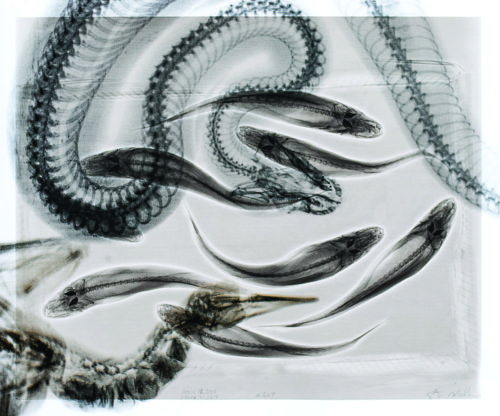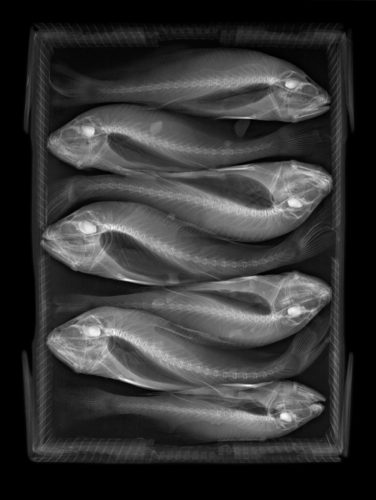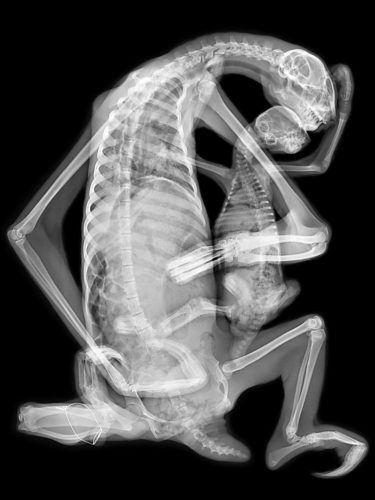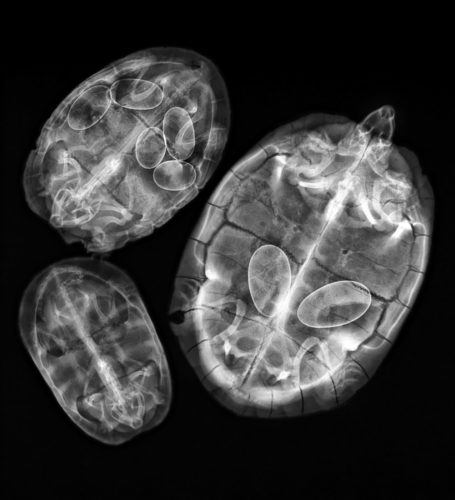
Book Review: Radiographic
By Isabella Weiss

Health of the Planet #669, 2014, carbon inkjet and silkscreen on cotton rag, 24 x 28.75 in.
From Radiographic by Steve Miller, copyright © 2017, published by Glitterati Incorporated www.GlitteratiIncorporated.com
“I have seen my death” exclaimed Anna Bertha Ludwig when she witnessed her own hand within the first X-ray image ever taken. For Ludwig, the X-ray represented death as the degradation of content and container and the revelation of a previously invisible internal structure. Steve Miller uses this medical technology as an artistic medium in his photo collection Radiographic as a modernized Vanitas: a visual warning regarding the the ephemerality of flesh, the body, the individual container. Although the Vanitas paintings to which Miller refers are of 17th-century Dutch origin, the term itself is Latin and signifies “emptiness.” Anna Bertha Ludwig perceived her personal death in an image of emptiness that unveiled an internal structure more sustainable and universal than her own identity (skin and blood, race and origin).
However, in Steve Miller’s X-ray photos, the interstices represent not the individual but rather the shared medium of all life, the porous material through which energy is disseminated, which expands when granted and shrivels when refused. These photographs inhabit a complex mediary between life and death. Humans, plants, and animals die as individuals as their flesh blends in the X-ray’s grey-green shadow. In Health of the Planet #669 (2014), fish, a bird, and a snake are superimposed, together creating a single, mesmerizing gesture across the cotton rag paper. In its stillness this image retains a superb sense of life and motion. As if painted in watercolor the animals bleed where they touch. These animals convene within the threat of their shared origin: Brazil’s ever-shrinking rainforest. This book is a foreboding chronicle of its subject’s peril, of their future disappearance. Miller captures the future death alive in the living.

Roots, 2008, carbon inkjet on cotton rag, 24 x 28 in.
From Radiographic by Steve Miller, copyright © 2017, published by Glitterati Incorporated www.GlitteratiIncorporated.com
Steve Miller’s work is contradictory in that it appears both skeletal and alive. Even his images of plants are dynamic, such as Roots (2008) in which an orchid appears to reach itself diagonally across the canvas and Fish Box (2011) in which a crate of dead fish appear afloat and expressive. Miller’s work in Radiographic represents the attempt to preserve life in the process of slipping away, an attempt that in its very act renders that life in skeletal form. Sloth Pieta (2011) is a stirring X-ray of a sloth and her child floating as if wrapped in a black womb. The image is both intimate and vulnerable: the two are isolated and yet utterly seen. The liveliness of their embrace and their skeletal appearance is at odds, just as the unborn eggs in Turtle Eggsbode the unavoidable end to new life. In Miller’s work, still-living animals are haunted by the image of their future remains and just cut flowers are petrified perpetually in the beauty of their suffocation.
Miller investigates the “Health of the Planet” and finds it in a state of rapid depletion. Stripped of the particularities of flesh and context, violated by the gaze of an X-ray, his subjects become symbols. These symbols are not historical because their death is an illusion. They represent a present in peril and a future still preventable. Steve Miller’s Radiographic is a volume of the unseen calling for its preservation.

Fish Box, 2011, carbon inkjet on cotton rag, 24 x 28.75 in.
From Radiographic by Steve Miller, copyright © 2017, published by Glitterati Incorporated www.GlitteratiIncorporated.com

Sloth Pieta, 2011, carbon inkjet on cotton rag, 26 x 24 in.
From Radiographic by Steve Miller, copyright © 2017, published by Glitterati Incorporated www.GlitteratiIncorporated.com

Turtle Eggs, 2011, carbon inkjet on cotton rag, 24 x 24 in.
From Radiographic by Steve Miller, copyright © 2017, published by Glitterati Incorporated www.GlitteratiIncorporated.com
